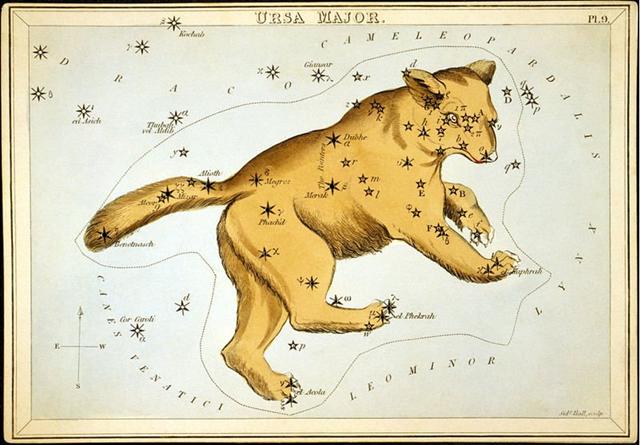|
2. The 3 + 1 feet of the Greater Bear probably has some special meaning, with the uplifted left front paw (not drawn in our modern constellation lines) as a special case:  We have earlier learnt about the right front paw (cfr at Museida and Talitha) and now we have reached to the right back paw. The right front paw coincides with the 3rd henua period, and although Talitha Australis at present is at the beginning of the 10th hour and not at the end of the 9th I thought it would be wise to have the southern star of 'the third leap of the ghazal' (κ) close to its preceding star (ι) - these letters are close in the Greek alphabet. ... Smyth wrote that this star has obtained the name of Talita, the third vertebra, the meaning of which is not quite clear [people always say so when they haven't got a clue]. Ulug Begh has it Al Phikra al Thalitha, perhaps for Al Kafzah al-thālithah, the third spring, or leap, of the ghazal; but he was not sufficiently comprehensive, for this last title was applied by the Arabs to ι and κ together; al Ūla, the First (leap), being shown by ν and ξ, and al Thānīyah, the Second (leap), by λ and μ - not δ and μ as that generally accurate author asserted. Hyde strangely rendered the original words of Ulug Beg as the Vertebrae of the Greater Bear, - whence probably Smyth's statement, - or the Cavity of the Heel, which, from the star's position in the figure, is a much more likely translation ... Wikipedia has other names too, namely the modern nickname Dnoces ['second' backwards] and Alphikra Borealis for ι respectively Al Kaprah and Alphikra Australis for κ ...
In The Little Bald Woman we rearranged the text to capture the 'small flies' (Muscidae) around the bear's muzzle:
Glyph number 73 (= 365 / 5 and 31 * 3 = 99) is, it seems, of central importance in Muscidae, but it can have several meanings. It could, for instance indicate the difference between 365 and 360 days, alluding to the dark period when ghosts and spirits can have their way - just the time for small flies. Some of my earlier comments:
From Acubens (α Cancri in day 136.0) to spring equinox on Easter Island there are 87 - (72 - 28) = 43 days rather than 50 as I wrote earlier. In Antipodal Stars spring equinox was found to be a week earlier than at viri in Ga5-11:
It seems possible there is more in common between the stars at high declination and low declination than what we outside the tropical belt can fathom. Therefore it ought to be meaningful to study the stars in Ursa Major although Leo rules the 11th hour. My reflections regarding the connection between the vero head of Cancer and 'the House of the Moon' fits with glyph number 267 as an illustration of how this season will be 'killed':
246 + 88 + 66 = 400. |
|||||||||||||||||||||||||||||||||||||||||||||||||||||||||||||||||||||||||||||||||||||||||||||||||||||||||||||||||||||||||||||||||||||||||||||||||||||||||||||||||||||||||||||














